Game Week Practice Planning to Defend the Spread Option Attack
by: Nick GiglioHead Coach Red Bank Regional High School (NJ)©
More from this issue
When we prepare to play against the spread option, we first need to understand that getting the most out of our practice time is the number-one priority. We understand that the option teams that we face run their offense at a high level and they have gotten hundreds of reps at what they do before we face them. So, we need to be able to get as many reps as possible in just one week.
For the past eight years, our philosophy has changed from trying to get good at practicing and playing one scheme vs. the option (See Diagrams 1 and 2)


to showing multiple defensive looks vs. option teams (See Diagrams 3-6). Both philosophies are based on our personnel and the personnel of our opponent at that time.

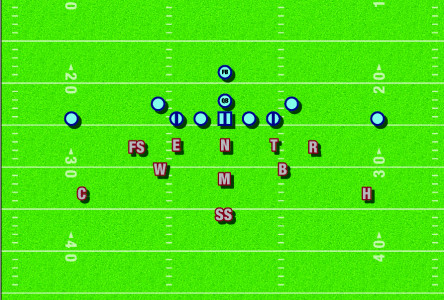
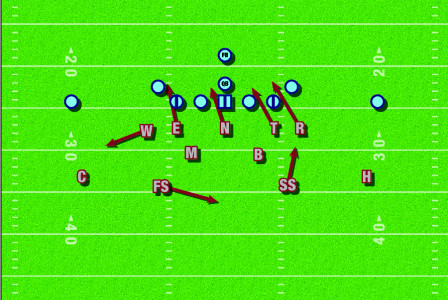
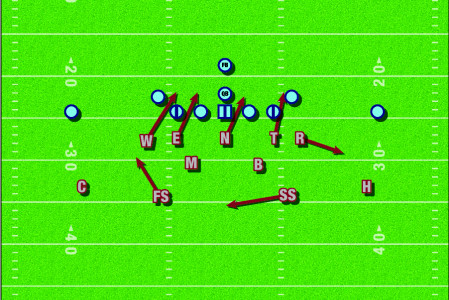
If we went with playing one scheme or playing multiple schemes, we knew we had to do certain things the same in our teaching progression. First, we wanted to teach from a “whole - part – to whole” progression. Second, we wanted to teach carryover in our concepts. Third, we want to get as many reps as possible at what we were doing in that one week. When I say reps, that primarily means physical reps, but as you will see it also means getting as many mental and visual reps at what the offense is running and what we are doing on defense.
It is extremely important to practice defending the option during your summer practices. By introducing our individual techniques and schemes in August, it gives us a foundation to draw from when it’s time to face our option opponents throughout the season.
The majority of our players play offense, defense, and special teams. This has to be taken into account when game-planning for defending the option. The last thing that we want to happen on the field is a mental mistake that will cost us a big play. Against the option, that could mean a touchdown.
Monday:
Monday is the day that we play our junior varsity games, so we only have about half of our team at practice. We start our ‘whole-part-to whole’ teaching progression Mondays. This starts in our defensive pre-practice period. At this time we would set up our base defense vs. the spread option. At first, we would teach the “fits” and responsibilities we must have on each play. We also want to start using our “option vocabulary” with our players, which helps with communication and understanding of responsibilities. We would explain what it means to have the dive, QB, pitch, and play-action pass responsibilities. We would then introduce the blocking variations of the top three plays in which we must defend (usually triple, mid-line, and center option). This period of pre-practice would be more recognition and mental preparation than physical preparation. This is the time when mental reps start to get introduced.
This period will run for 15 minutes. After teaching the “whole” aspect of the offensive schemes we are seeing, we teach the defensive schemes we are installing. We then break to an option circuit to teach everyone how to defend the QB, pitch and alley, and veer and zone schemes (See Diagrams 7- 9). This circuit is important in many ways primarily because it gets everyone on the same page on using our base techniques for defending each phase of the option game. This option circuit will be a 15-minute period.

The Feather QB Drill (Diagram 7) involves three players, a defender, QB and pitch man in a 10-yard cone square. The defender starts off-2 by-2 yards from the QB with the pitch man 2-by-4 yards outside the QB. The defender is in a two-point stance with his inside foot slightly up. The defender is a QB player first. As the QB attacks downhill at him, he will sit heavy on his inside foot. The defender will sit and bounce slightly on the balls of his feet and push off of his back foot and commit to the QB when he gets within arms distance from him. If the ball gets pitched before that, the defender will push off of his front foot and point his back foot downhill and spring to pursue the pitch man downfield (keeping his outside foot back).
The reason for the slow-play techniques is to provide time for other defenders to help once they have played their own assignment. This also allows us not to commit to the QB after he pitches the ball. We want that defender to help get involved in the pitch man. We do have change-ups in our schemes to provide the QB with a different look that changes the tempo of his read. We make this drill competitive by providing a point system for the drill: QB scoring or being stopped is two points to either side, and pitch man scoring is one point to either side.
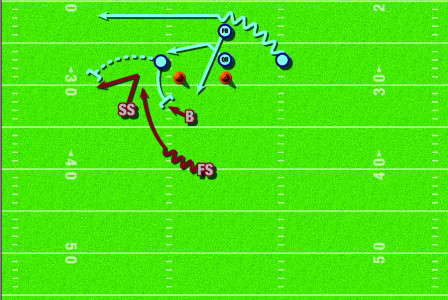
The Pitch and Alley Drill (Diagram 8) involves seven total players, four on offense and three on defense. In this drill, we will work on slow-playing the pitch as well as our alley fit safety play. We also work on our inside linebacker fit vs. WB seal block and WB arc block schemes. We have our front side WB use a shield and execute an arc block on the OLB or seal block on the inside linebacker (a coach will stand behind the FS and direct which scheme to use). Our pitch player plays pitch very similar to how our QB defender plays the QB. We want to close the distance inside while keeping leverage on the pitch player with our outside foot back. We do not want to get upfield and create a natural alley in which the QB can run. Plus, this creates a big alley for our FS to fill. Our FS fills the alley, which means he plays dump pass to alley with alley defined as QB to pitch inside-out (D-Gap on out). Our inside linebacker will practice taking on the seal block of the WB or scraping and playing the inside half of QB vs. WB’s arc block.
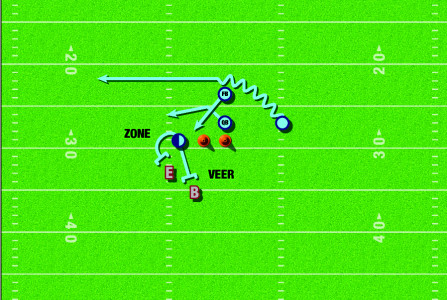
The Veer and Zone Drill (Diagram 9) involves two defensive players and offensive players. The pitch man is involved, just for timing. This drill teaches our natural “X” concept in our defense between our defensive end and the linebacker. The first of the two schemes that we will run is the zone scheme which puts our DE in the C-Gap and our linebacker in B-Gap. The next scheme is the veer scheme which switches our DE in the B-Gap and our linebacker in the C-Gap. The DE vs. the zone scheme will attack the OT’s outside “V” of his neck and “push-pull”-locking out his outside arm while keeping his outside arm and leg free in the C-Gap. With the veer scheme, the DE will squeeze the OT down into the B-gap, taking the FB by grabbing his outside shoulder and putting it across the FB. We do not try to tackle the FB with just an arm tackle because that is not in our favor as a defense. This drill teaches the linebacker to read ‘Clear-Cloudy’ from the B-gap on out. The zone scheme teaches the linebacker to have a “clear” read and attack the B-Gap while the veer scheme teaches the linebacker to read “cloudy” and scrape tight through the heels of the DE into the C-Gap. A coaching point is to have the linebacker scrape tight into the C-Gap, leaving no space between himself and the next defender inside him.
The next 20 minutes of defense on Monday will consist of each position working on their techniques and reads during an individual period. During this time, each position will work on three individual “parts” to the “whole” scheme. This is a time where we would like to get as many individual reps as possible on what we are asking each defensive position to do. The coaching staff will take our defensive schemes and coach all the variables that their positions need to work on within that scheme. Again, Monday is the day to start getting our keys and reads in place for the week. We hope that as the week goes on we will be reading and repping at a faster pace than when we began on Monday.
Tuesday:
Tuesday is our main defensive day. We will have a total of 80 minutes of defense on this day. The first thing that we do is get the scout team on the field before pre-practice and have our coaching staff coach them on proper alignments, motions, and top option plays we have to defend. During pre-practice we will then take this 10-minute period and drill what we call “option skeleton period” (Diagram 10).

I would play QB and have only a FB, two WB’s and two WR’s aligned in a spread set. Our D-Line coaches will play QT or OB depending if we are running triple or mid-line and they will take the first three steps or their blocking scheme on snap. I will run triple with a loop and veer scheme to each side and play action pass to each side. This is a rapid-fire period that I will tell our defensive and offensive players the blocking scheme that they will get on each play. They will then react to it appropriately and run to their assignment and to the ball. This period is a great way to get reps, to teach assignments, and practice team pursuit. This period also provides our players with the confidence at defending one or two schemes of the option at a time. We are not trying to trick our defense but rather just trying to get good quality reps. A key component of defending the option is to get our scout team to duplicate the option as best they can throughout the week because we know it will be run at a faster speed on game day.
Tuesday’s defensive practice will consist of 85 minutes:
10 min: pre-practice
12 min: tackling circuit
20 min: individual
15 min: half line perimeter run
15 min: inside run period (Corners + 1 on 1’s, stalk block, crack and replace)
13 min: defensive 7 on 7 (D-Line + pass rush, reverse, screen)
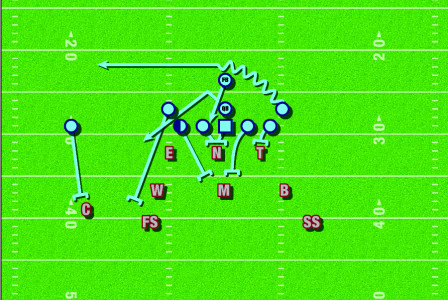
During our half line period (Diagram 11), we will work against triple, mid-line, play action pass, and rocket sweep only. Our coaching staff will work to provide constant feedback to their positions after each play, letting them know what they did correctly and incorrectly. The coaching staff will be constantly asking our players what they saw and what they need to be looking at on each snap. Playing great defense and especially defending the option starts with getting our defenders to be looking at what they should be. This will allow them to waste little time getting to their assignment.
During our tackling circuit, we will try and get more reps at what we are doing by having our circuit be option-oriented. The first circuit we will work is dive tackle, circuit two is alley inside-out tackle, and circuit three is pitch outside-in tackle. During our perimeter run half-line period (Diagram 12) we will work on all of the perimeter blocking schemes we will face (e.g., seal scheme, arc scheme, switch scheme) and the play action pass off of them. Our inside period (Diagram 13) will consist of defending the FB game, Counter game, and QB Duck game. We will finish our Tuesday defensive day with 7 on 7 pass practice (Diagram 14). This period will consist of any three-step boot game and any play action pass game that we have to defend. At the end of Tuesday’s practice our conditioning will consist of a defensive pursuit period. We will run our “option skel period” again during this time. A rapid fire period will reinforce what we coached throughout the practice. Again, we’re just trying to get as many reps as possible throughout the week.
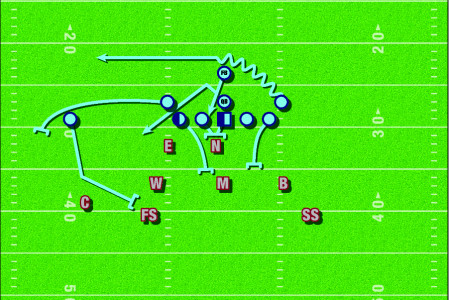
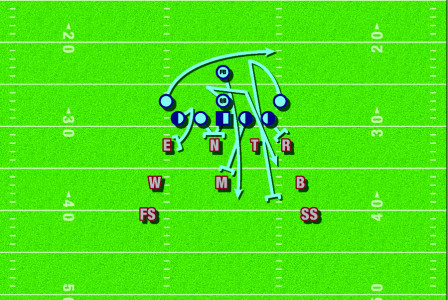
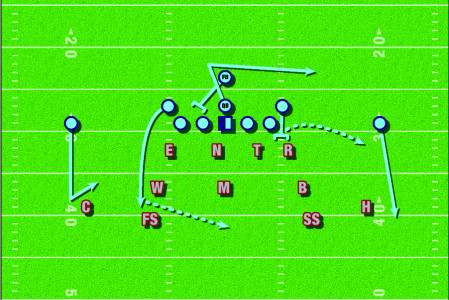
Wednesday:
Wednesday is an offensive emphasis day which means we will have 50 minutes of defensive time.
Wednesday’s defensive practice will consist of:
10 min: Option Skel (also involve reverse)
10 min: Individual (DL and linebackers together)
15 min: Half line
15 min: Team Defense
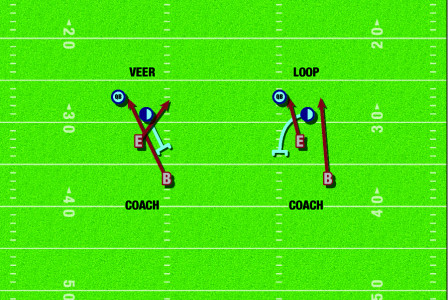
During our individual period, our DL and linebackers will work together and work on the loop and veer schemes in groups of three: OT/DL/LB (Diagram 15). The OT will either loop or veer and the DL and LB will react accordingly. This is a quick multiple rep drill. Next, our half line will be similar to Tuesday except it will be performed at a greater speed. We will also add the next top play our opponent runs into our half line period. This will be the first time we will run our team defense vs. a full offense. Our team defense will primarily be against all of the counters we will see that week. We will continue to coach our keys, reads, and techniques that we have installed since Monday. Wednesday practice is our film day with our players. While watching films, we will quiz our players on their assignments and reads.
Thursday:
When playing on Friday night, our Thursday practice is more than a walk-through, but not as intense as a Tuesday practice. We will have 45 minutes of defensive time, which will consist of group and team periods.
Thursday’s practice consists of:
15 min: Goal line and short yardage
15 min: Perimeter run and play action pass
15 min: Defensive team (vs. inside run, counter game, reverse)
Thursday’s practice should be fast, crisp, and should involve our coaching staff quizzing our players throughout the defensive period. Establishing an “option vocabulary” helps with keeping communication short and to the point on each play. This alone will save time in practice and eliminate mental mistakes and confusion on game day. At the end of practice, our players will receive a tip sheet which will summarize the week of practice and allow for material that they can bring home with them to review.
Friday: Game Day
Players will come see me throughout the school day if they have any questions regarding our defensive scheme. Before we take the field for pre-game, we will meet as a team to emphasize the strengths of our opponents and what our goals are during the game.
Defending option football takes more than just one week. The foundation must be laid during your pre-season camp in August. Once the week starts, you must find multiple ways to get as many quality reps as possible. Players should always be repping physically, but also mentally throughout the week. Create an option vocabulary among your players that will help save time and eliminate confusion. Whichever philosophy you go with, being multiple or staying more base, you must teach and emphasize the fundamentals of how you are defending the various phases of the option attack.
Preparing to defend the spread option takes more time than you actually have. The teams that we face do an excellent job of running their option attack so we must first look to install defensive option concepts in pre-season camp in August. This helps our players understand it quicker when it comes to game-week preparation during the season. We try to get as many quality reps as possible each week, teach carry over concepts, and to never add additional schemes if our fundamentals of playing the various phases of the option are not perfected first.




















